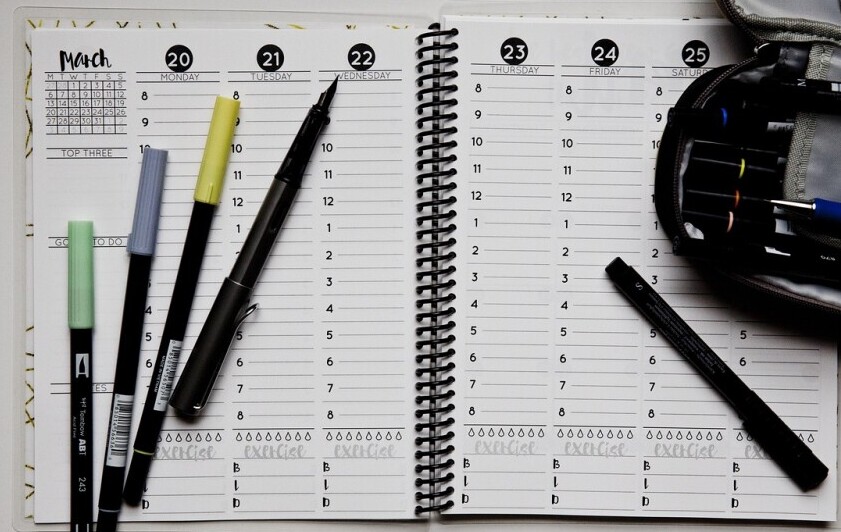Working From Home
Since Covid more and more people are now Working from Home, the debate about working from home was gaining traction prior to Covid as it was seen as cost effective to businesses. During the Lockdown, countless people was suddenly thrust into the world of remote work. And with increased encouragement to maintain social distance, many people started to work from home without any transition.
But while working from home offers many advantages, it also offers some unique challenges. Here are seven tips to help those who will be working from home for the foreseeable future:
Have a dedicated workspace.
One of the biggest challenges of working from home is all the distractions: your family. Your pets. Your kitchen.
It is extremely important to have a dedicated workspace. If you have room for a separate home office, perfect. But even if you don’t, you can make do with a small desk or table. The key is to use a room where you can close the door and achieve a bit of solitude.
Some people may choose to go to a local coffee shop and set up there for a change of scenery. Make sure you choose somewhere with WI-Fi!
If thats Not possible then why not invest in a good pair of noise-canceling headphones

Working From Home Plan “work time.”
One of the best things about working from home is the control it gives you over your own schedule. But it’s easy to run out of time or energy for work without a good structure in place.
If you’re like me, your mind works best in the morning after a cup of coffee. Some People might start thier day with a workout or by running personal errands.
Equally important is scheduling a time to stop work. It’s very important to know how to switch off. The danger when working from home is that work and personal life start to blend together, and you begin to feel like you’re always thinking about work. You need a work/’homelife divide.
To help with this, choose a time specific times to work. Even if the checkout is simply mental, it will help provide the separation you need to maintain a work-life balance.
Schedule time for Working from Home
In addition to scheduling your general work time, you should also schedule time for focused work. Have a set time each day if that works for you. MAke sure duiring this focused time you have no distractions. YOu will be very productive during this time period.

Time for email and meetings and Admin
So if you use prime time for focused work, when should you respond to emails and take meetings?
I find time to check my inbox, normally 20 minutes is enough and I usually use my phone so I can voice dictate replies. Remember to speak precisly and clearly!
Meetings can be a little bit more tricky as other people will have their own agendas when working from home. in my work I have to visit people at their homes so I tend to do these between 11am and 3pm, this allows me to process outstanding paperwork from those appointmentson my retrun home, this is my focuse work time.
Take proper breaks.
When Working from Home be careful to tie in short breaks into you day, this wil lhelp you maintain your focus, how long for will depend on you as an individual. It is alos good to stay hydrated to keep your foccus.
It also depends on the complexitiy and length of the task ytou are woring on.
The key is to make sure you take time to refresh your mind and body. Remember that a five to 15 minute break will make all the difference, as will a proper break for lunch.
Lunchtime walk
a short walk can be great to recharge yourself, especially if you have a park nearby.
Sometimes, just a walk around your stree is enough to get you past the problem you’ve been stuck on. But even better is a short walk outside, for 20 minutes.Plus you will wrok towards your step count!
The combination of fresh air and different scenery is invaluable in helping to get the creative juices flowing.

Communication is key
Good relationships are built on a foundation of good communication.
While I try not to get bogged down too much by email and instant messaging, these tools are still very useful for staying in touch with colleagues and maintaining those relationships.
And while there’s no true replacement for an in-person meeting, online conference tools like Zoom and Skype allow you to see the other person’s facial expressions and body language, in addition to hearing their voice.
So, ready to get that quarantine life on? As you begin your new routine of working from home, remember:
1. Have a dedicated workspace.
2. Schedule work time (including “checkout” time).
3. Schedule time for focused work.
4. Use downtime for email and meetings.
5. Take breaks.
6. Go for a walk.
7. Communication is key.
Follow these simple steps, and trust me: You’ll never want to go back to the office.
And you’ll set yourself up to do the best work of your life.
Google, Microsoft, Twitter. Hitachi, Apple, Amazon. Chevron, Salesforce, Spotify. From the UK to the US, Japan to South Korea, these are all global companies that have, in the last few days, rolled out mandatory work-from-home policies amid the spread of Covid-19.
And it’s realistic to assume that shifting to the ‘home office’ will become the new normal for many of us for a while, given Wednesday’s announcement by the World Health Organization that the coronavirus has officially reached ‘pandemic’ status.
Some employees will be working from home for the first time, which means figuring out how to stay on task in a new environment that may not lend itself to productivity. But there are ways to deliver results and avoid going stir-crazy, from setting up a good workspace to the way you talk to your team.
Crank up the communication
Coronavirus or not, the key to working from home is clear communication with your boss – and knowing exactly what’s expected of you.
“Have really clear-set expectations for communications day to day,” says Barbara Larson, a professor of management at Northeastern University in Boston who studies remote working. “Ask [your manager] if they don’t mind having a 10-minute call to kick off the day and wrap up the day. Often times, managers just haven’t thought of it.”
1) Know Your Work-style
Working from home (WFH), like any form of remote work, presents new challenges and opportunities that require you to approach work differently. The great news is that you have more freedom and control over how you work, but to make that more impactful you need to align how you work from home to your work-style.
Does your creativity and productivity peak in the morning or the afternoon? Are you a lark or an owl? Do you work better with your head hunkered down in silence or do you thrive with music and background noise? By figuring all that out and planning your working from home experience and environment around it, you’ll be more productive and more satisfied.
Take some time to sit down, understand your work-style better and use those insights to plan your approach. This is the foundation of working from home.
2) Create Your Workspace
A big part of effective working from home is making it feel like work and the physical workspace you choose is central to this. You don’t need a home office or make any big investment, just a bit of planning. And maybe moving some furniture around.
What kind of workspace best suits your work-style? Is the kitchen table going to do the trick or will you need something bigger? Will having other people around help you or will you need to work in a separate room? Does a window looking out on the world inspire you or distract you? Do you want to be near a wall so you can put up some Post-its? Will you need somewhere to store documents? Position your workspace in such a way that you can concentrate and have the resources you need.
One of those critical resources is a good internet connection, so find out where in your home gets the best Wi-Fi reception. If you are doing many video calls, you may need to make one small investment in an ethernet cable. Wi-Fi can be unreliable and a wired connection will lead to better call quality.
Think about how your workspace will look and sound on an audio or video call. Will there be a lot of background noise? More importantly, what will everyone else on the video call be seeing behind you? Do they see a messy kitchen behind you, a pile of laundry or do they see a tidy, professional background?
If you’re going to be working remotely for an extended period, try to make this workspace semi-permanent, so you can return to it each day and pick up where you left off. It makes it feel like your personal space.

3) Get Into The Right Mindset
When it’s finally time to start your first day working from home, it’s not just a matter of opening your laptop and sitting at the kitchen table all day in your pajamas. Try to make it feel like work, which can be a challenge when surrounded by your home, family or pets. But making that mental shift to “work” will help your focus and productivity. If you’ve set up your workspace in the right way, you’re already halfway there.
One simple trick to make that mental shift is to dress in such a way that it feels like work, which likely doesn’t mean sweat pants. You don’t need to go formal, but dressing like you do at work, even a little, will remind you that you’re in work-mode now. If you’re going to be doing video calls, you should be doing this to give the right professional impression to your colleagues and customers.
Finally, make sure to start and end each workday at around your usual time. While there is a natural and admirable tendency to start earlier or work later because your commute time is now zero, try to stick to your regular work schedule to make it feel like work.
4) Schedules And Routines Keep You Focused And Motivated
You’ll likely have fewer meetings and distractions from colleagues or bosses. While that can lead to the challenge of social isolation—more on that later—it gives you a chance to be more in control of your schedule, focus more on a few big tasks and dive into them for a few hours.
To build your workday focus, plot out what you want to accomplish each day and chunk out time for each of your tasks. Schedule creative tasks to the times when you’re most innovative and routine work to the times that you’re not. Build in time for daily rituals and routines, like the morning email check, team call or administrative tasks.
Try to schedule your entire week in advance. My first task on Monday mornings is to take a piece of graph paper, create a column for each day of the week, and write what I want to accomplish each morning and afternoon, Monday to Friday, and put it on the wall in front of my workspace. As I go through the week, I cross off what I’ve done and adjust the next day as needed. Friday afternoon, I reflect on the week and make some notes for the following week and repeat the process on Monday morning. Seeing a visual record of what I’ve accomplished each week gives a sense of accomplishment that is incredibly motivating.
5) Watch Your Physical And Mental Well-being
Working from home has some unique stresses, and social isolation is top. We’re social animals, and working at home all day can affect our physical and psychological health. But you can fight it.
Keeping in touch with your colleagues is vital, and email isn’t enough. Find the time for virtual water cooler chats with your colleagues, even to make small talk. Set a dedicated time each day to do this, whether they’re also working at home or are at the office, and make it a video call to strengthen that social bond. It keeps your team strong and you mentally fit, with the added benefit of helping you keep up with what’s going on in the company. Don’t feel bad about suggesting meetings by video through Skype or Zoom—you may not be the only one who prefers live communication to solely relying on email and chat.
If you work at home with your family or loved ones, get an emotional recharge and inspiration from them when you need it. Take advantage of being at home.
Look after your physical health. Stand once an hour. Do some stretches. Go for a morning walk or run to start the day or during the day. When I began working from home two days a week, I realized I was walking less and burning 1,000 fewer calories a week, so I make an effort to go for a walk or run at lunch when I work from home. Weight gain can be an unexpected side effect of WFH so find time to head out into the world or go to the gym. Exercise, even a short walk, has been proven to boost your creativity and mood.
6) Make Lunch Into An Event
Lunch is an excellent opportunity to develop a routine, combat social isolation and stay physically fit. Eating lunch at your desk is a bad idea and a wasted opportunity to utilize the freedom of having lunch at home. Make lunch a part of your routine and make it count. Get out and check out that restaurant in the neighborhood that’s always packed in the evening. Meet with other people. Have lunch with colleagues if possible.
Don’t feel bad about going out for lunch, a run, or taking a walk while working from home—it’s good for you and for your company because you become more creative and focused.
I hope this helps you when working from home , there can be so many distractions at home but its a growing niche that sent going away.
